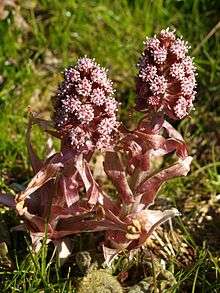Petasites hybridus
Petasites hybridus, the butterbur, is a herbaceous perennial flowering plant in the daisy family Asteraceae, native to Europe and northern Asia.
| Petasites hybridus | |
|---|---|
 | |
| Inflorescences | |
| Foliage | |
| Scientific classification | |
| Kingdom: | Plantae |
| Clade: | Tracheophytes |
| Clade: | Angiosperms |
| Clade: | Eudicots |
| Clade: | Asterids |
| Order: | Asterales |
| Family: | Asteraceae |
| Genus: | Petasites |
| Species: | P. hybridus |
| Binomial name | |
| Petasites hybridus | |
| Synonyms | |
| |
Description
The species is dioecious, the male and female flowers being borne on separate plants. In Britain, the male flowers are widespread, but the female flowers have a restricted distribution in northern and central England.[1]:810 The flowers are produced in the early spring, before the leaves appear. They are pale pink, with several inflorescences clustered on a 5–20 cm (2–8 in) stem. The leaves are large, on stout 80–120 cm (31–47 in) tall stems, round, with a diameter of 40–70 cm (16–28 in) with petioles up to 1.5 m (4 ft 11 in).
It is also called bog rhubarb, Devil's hat, and pestilence wort. Synonyms include P. officinalis, P. ovatus, P. vulgaris, and Tussilago petasites L.[2]
Distribution
It is native to central Europe, extending from the British Isles to the Caucasus, and from southern Italy north to southern Scandinavia.[3] It is present as an introduced species in North America.[2] In the British Isles, female plants are rarely found outside central and northern England, and the species may be naturalized as clonal populations outside this area,[1]:810 propagating via rhizome fragments. The preferred habitats are moist, fertile soils, often by rivers, streams and in wet meadows.[4]
Herbalism
Petasites hybridus leaves have been used in the traditional Austrian and Czech medicine internally (as tea or cold maceration in ethanol) and externally (as compresses or maceration in vinegar) for treatment of infections, fever, flu, colds, hay-fever, and allergies.[5]
Potential medicinal uses
Preliminary trials have shown a preparation of butterbur root to be effective in reducing the frequency and severity of migraine attacks.[6] A commercial extract Petasol butenoate complex (Ze 339) has proved helpful for allergic rhinitis.[7][8] An evidence-based 2005 systematic review including written and statistical analysis of scientific literature, expert opinion, folkloric precedent, history, pharmacology, kinetics/dynamics, interactions, adverse effects, toxicology, and dosing is available from the Natural Standard Research Collaboration.[9]
References
- Stace, C. A. (2019). New Flora of the British Isles (Fourth ed.). Middlewood Green, Suffolk, U.K.: C & M Floristics. ISBN 978-1-5272-2630-2.
- "GBIF Petasites hybridus (L.) G. Gaertn., B. Mey. & Scherb". Copenhagen, Denmark: Global Biodiversity Information System.
- Anderberg, Arne. "Petasites hybridus (L.) P. Gaertn., B. Mey. & Scherb". Naturhistoriska riksmuseet, Stockholm.
- "Online Atlas of the British and Irish Flora, Petasites hybridus (Butterbur)". Biological Records Centre and Botanical Society of Britain and Ireland.
- Sylvia Vogl; Paolo Picker; Judit Mihaly-Bison; Nanang Fakhrudin; Atanas G. Atanasov; Elke H. Heiss; Christoph Wawrosch; Gottfried Reznicek; Verena M. Dirsch; Johannes Saukel; Brigitte Koppa (2013). "Ethnopharmacological in vitro studies on Austria's folk medicine – an unexplored lore in vitro anti-inflammatory activities of 71 Austrian traditional herbal drugs". Journal of Ethnopharmacology. 149 (3): 750–771. doi:10.1016/j.jep.2013.06.007. PMC 3791396. PMID 23770053.
- Taylor, Frederick R. (2011). "Nutraceuticals and Headache: The Biological Basis". Headache: The Journal of Head and Face Pain. 51 (3): 484–501. doi:10.1111/j.1526-4610.2011.01847.x. PMID 21352223.
- Dumitru, Alina F.; Shamji, Mohamed; Wagenmann, Martin; Hindersin, Simone; Scheckenbach, Kathrin; Greve, Jens; Klenzner, Thomas; Hess, Lorenzo; et al. (2011). "Petasol butenoate complex (Ze 339) relieves allergic rhinitis–induced nasal obstruction more effectively than desloratadine". Journal of Allergy and Clinical Immunology. 127 (6): 1515–21.e6. doi:10.1016/j.jaci.2011.02.045. PMID 21489609.
- Dumitru, AF; Shamji, M; Wagenmann, M; Hindersin, S; Scheckenbach, K; Greve, J; Klenzner, T; Hess, L; et al. (2011). "Petasol butenoate complex (Ze 339) relieves allergic rhinitis-induced nasal obstruction more effectively than desloratadine". The Journal of Allergy and Clinical Immunology. 127 (6): 1515–21.e6. doi:10.1016/j.jaci.2011.02.045. PMID 21489609.
- Giles, M.; Ulbricht, C.; Khalsa, K.P.S.; DeFranco Kirkwood, C.; Park, C.; Basch, E. (2005). "Butterbur: An evidence-based systematic review by the natural standard research collaboration". Journal of Herbal Pharmacotherapy. 5 (3): 119–143. doi:10.1080/j157v05n03_12.
External links
